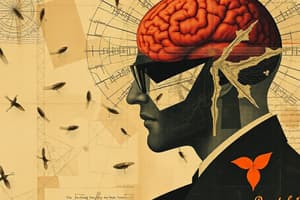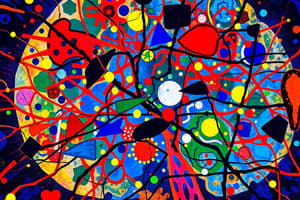Podcast
Questions and Answers
What significant contribution did Santiago Ramón y Cajal make to the understanding of the nervous system?
What significant contribution did Santiago Ramón y Cajal make to the understanding of the nervous system?
Which field of study initially captivated Cajal's interest before pursuing medicine?
Which field of study initially captivated Cajal's interest before pursuing medicine?
What was Cajal's primary scientific focus by 1885?
What was Cajal's primary scientific focus by 1885?
What technological advancement was crucial for Cajal's research success?
What technological advancement was crucial for Cajal's research success?
Signup and view all the answers
Which staining technique did Cajal modify to visualize the human brain tissue?
Which staining technique did Cajal modify to visualize the human brain tissue?
Signup and view all the answers
When did Cajal demonstrate that nerve cells are discrete units?
When did Cajal demonstrate that nerve cells are discrete units?
Signup and view all the answers
What landmark publication did Cajal release in 1899?
What landmark publication did Cajal release in 1899?
Signup and view all the answers
Who shared the Nobel Prize with Cajal for their work on the nervous system?
Who shared the Nobel Prize with Cajal for their work on the nervous system?
Signup and view all the answers
What profession did Cajal's father practice?
What profession did Cajal's father practice?
Signup and view all the answers
What did the images accompanying the text showcase?
What did the images accompanying the text showcase?
Signup and view all the answers
Flashcards
Santiago Ramón y Cajal
Santiago Ramón y Cajal
A Nobel Prize-winning neuroscientist known for studying the nervous system.
Independent cells
Independent cells
Nerve cells that communicate while functioning as separate units.
Histology
Histology
The study of the microscopic structure of tissues.
Golgi stain
Golgi stain
Signup and view all the flashcards
Microscope advancements
Microscope advancements
Signup and view all the flashcards
Nervous system structure
Nervous system structure
Signup and view all the flashcards
Magnum opus
Magnum opus
Signup and view all the flashcards
Nobel Prize in 1906
Nobel Prize in 1906
Signup and view all the flashcards
Neural communication
Neural communication
Signup and view all the flashcards
Artistic influence on science
Artistic influence on science
Signup and view all the flashcards
Study Notes
Nobel Prize Winner Santiago Ramón y Cajal
- Cajal, a Spanish neuroscientist, was rebellious at first but persuaded by his father to pursue medicine, merging his artistic talents with scientific interests in neuroscience.
- Cajal initially used microscopes for anatomical studies, then broadened his research to histology and the nervous system.
- His work revolutionized understanding of the nervous system as made of independent cells, not a continuous web, by using improved staining techniques and microscopes to visualize individual structures and cells precisely.
- Improved microscope technology and staining methods were crucial to understanding the nervous system.
- His work illuminated the detailed structure of the human nervous system.
- He received the Nobel Prize in 1906 for his work on the nervous system's structure, sharing the award with Camillo Golgi.
- Cajal developed and improved staining techniques to visualize the structures of the nervous tissue better.
- His detailed illustrations played a crucial role in the field of neuroscience.
Studying That Suits You
Use AI to generate personalized quizzes and flashcards to suit your learning preferences.
Description
Explore the life and contributions of Santiago Ramón y Cajal, a pioneering neuroscientist who revolutionized our understanding of the nervous system. Discover how his artistic talents complemented his scientific pursuits, leading to groundbreaking studies in histology and cell theory. Cajal’s advancements in staining techniques and microscopy earned him the Nobel Prize in 1906, solidifying his legacy in neuroscience.





